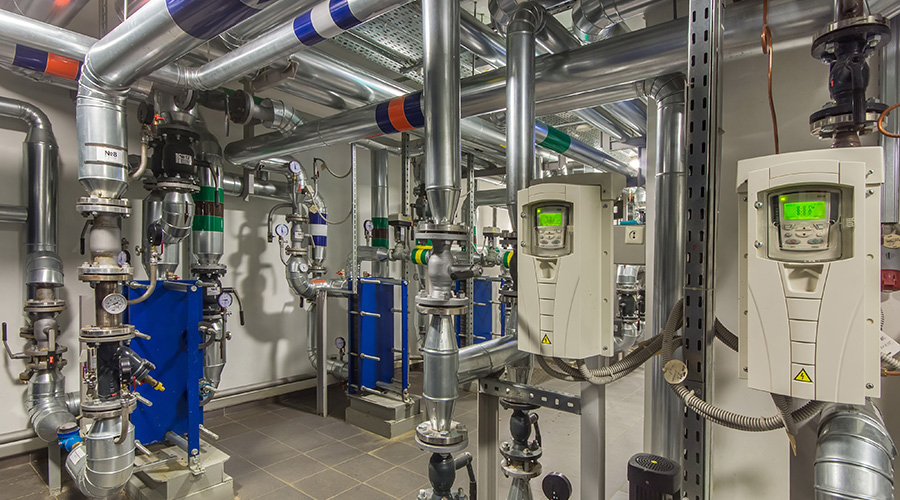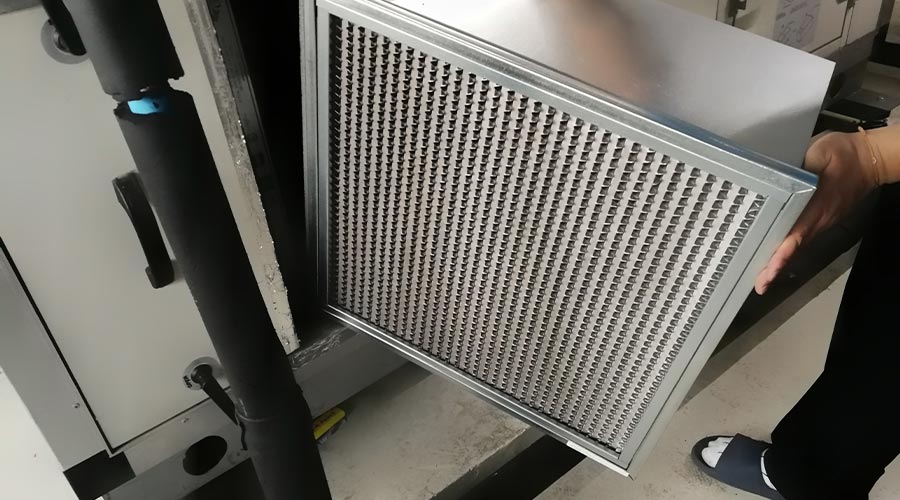Writing Good HVAC Specifications
By Naomi Millán, Associate Editor
OTHER PARTS OF THIS ARTICLEPt. 1: This PagePt. 2: HVAC Product Showcase
Of all the systems in a building, HVAC is the one occupants are most acutely aware of. A well-selected and installed HVAC system can greatly enhance the comfort and productivity of occupants. Likewise, a poorly selected system will cause endless headaches for the facility executive, whether they’re hot/cold calls, indoor air quality problems or astronomical energy bills.
It’s no surprise that HVAC issues demand a lot of a facility executive’s time. But facility executives should budget their HVAC time wisely. That means investing time during the front end of the design process for any significant new HVAC system. Serving as a key link between design ideas and operational realities, facility executives need to be present and active during the specification process to ensure the system called for will fit the facility’s needs.
Veteran facility executives have learned which questions to ask and problem areas to watch out for through trial and error. But for those newer to the process, keeping a few important concepts in mind can save a lot of headaches later on. The things to keep in mind are that in order to get the best possible system specified and installed, facility executives should perform preliminary research, stay in a dialogue with the design team and provide oversight during the construction process.
The HVAC system is significant not just in scope but in its financial impact, says Stan Peregoy, president of Calvert Jones, a mechanical engineering firm. HVAC accounts for 25 percent of the original construction budget and 43 percent of the operating budget. The other heavy hitter is the lighting system, so it’s important to ensure that these two key functions have been designed correctly, Peregoy says.
There are plenty of ways that HVAC designs can go wrong. Some run over budget. Others include components that don’t perform to the specification. Still others are underdesigned, skimping on the specification to cut first costs, but practically guaranteeing problems and higher costs down the road.
Do Your Homework
The first task for facility executives when they learn of a major new HVAC system going into their portfolio is to do their homework. They should familiarize themselves with the submittal procedures, the design standards and code standards, especially if their portfolio covers a large geographic area with different standards, says Michael Cooper, principal with Harley Ellis Deveraux, a design firm.
One important component to analyze is the construction budget for the project and the expectations for operational costs.
“Make sure a spec isn’t written that is beyond your means,” Cooper says. “One of the greatest frustrations in the design process is to get to the end and find out you can’t afford it.”
An issue that can sometimes affect the quality of a specification is if there is a hesitation to pay for a high level of quality, says Peregoy. “The owners beat down on the architectural and engineering fees,” he says. “It’s then very hard to get a properly designed spec.” Cheaping out on the front end could create vague language in the spec, which is then passed on to the contractors who “should have known” what was intended.
Peregoy also cautions facility executives against accepting the budget proposed by the architect or engineering firm at face value. “They always undersell it,” he says. Then comes the process of value engineering to try to make it work.
The best step facility executives can take to ensure the quality of the HVAC system is to select a good team and follow an integrated design process. First off, choose a good engineering firm. “It’s just like picking a doctor,” says Peregoy. “You need to do your homework. Some are great. Some are not.”
Getting a general contractor and construction team on board at the same time would be a good idea, he says. “You’ll get everything taken into consideration. Almost all of the problems are taken care of before they become problems.”
Without an integrated design process, information flow can be fractured. For example, often the people who produce the specs and produce the drawings are not the same people. The lower the level of collaboration, the higher the likelihood errors will be introduced and overlooked. And then you end up with a scene out of a Western, Peregoy says. Everyone is pointing fingers at someone else.
In some cases, getting to the design table can be tricky or impossible for facility executives. If a developer is building the building, the investors won’t have integrated design on their minds, says Jack Althoff, owner’s representative with ProJeX Inc. “It would be smart if the facility executive was involved from the beginning, but that’s not how it works,” he says. However, in a design-build project, it’s more common for the facilities person to be involved to help decide among the options, he says.
The benefit of having the facility executive on board during the design process is that he or she can bring actual building knowledge to the table. “Facility executives have knowledge of how buildings really function,” says Cooper. “The AE’s core expertise is in designing systems, not operating and maintaining them.”
Facility executives can bring to the designers an understanding of what energy savings initiatives pay back in a reasonable amount of time, what the operations and maintenance staff will be capable of and a realistic perspective on how a building functions, he says. “It is a gross error to not involve them.”
Performance Expectations
An important way facility executives can bolster the specification process is by making the performance expectations clear to the design team right off the bat. One of the aspects to clarify is the expected energy performance of the system. Facility executives should make sure the design team understands the organization’s energy goals. Sometimes these goals are tied to promises made to future tenants, so it might behoove facility executives to check in with the leasing agent to see what was sold.
Expectations of energy performance need to be made clear at the beginning of the specification process, as they will influence the entire design. “If you wait to take in those considerations to the end, it will be too difficult, time-consuming and costly to stuff them in,” Cooper says.
If there are any specific cutting-edge energy efficient technologies a facility executive would like to use, he or she will most likely be the one to initiate that conversation. “A lot of engineering firms are not on the cutting edge with different technologies,” says Peregoy. “If they don’t believe in it, they’re not going to design for it.” For this reason, facility executives should seek out firms with prior experience designing the kinds of systems in which they are interested.
It falls to the facility executive to understand the level of risk the organization is willing to accept in a design, says Althoff. “There may be a new pump out there and it may be cheaper, but you don’t want to be the guinea pig,” he says. Adopting new technology requires the facility executive to understand the benefits and risks. To educate themselves on the risks and benefits, facility executives can look for information through organizations such as ASHRAE or consult with a knowledgeable and impartial third party, such as a project management company acting as the owner’s representative.
The level of technology specified will also depend on the facility executive’s team’s ability to maintain the system. A speculative office without in-house maintenance people will require a more basic HVAC system that’s easy to troubleshoot and adjust. A large research facility with a population that’s more in tune to energy efficiency will have the resources for and interest in a more complex system. “You want the HVAC engineer to know about your staff, what they know and how they work,” Cooper says. “You want a system that will work for the people that you have.”
Beyond the Drawing
A good HVAC specification goes beyond the components of the system to the construction and hand-over process. Before the construction phase, facility executives should have prebid meetings with prospective contractors to walk through the project so the construction team understands the design intent.
If a very sophisticated system will be installed, facility executives should make sure factory or field runs of the system are specified. With these systems, it isn’t enough to do a visual check, says Cooper. If it is factory tested, travel to the factory to see how it works, he says.
Design Team Expertise
Facility executives should consider engaging the design team to provide construction administration services. That way they can answer any questions on the spot so construction is conducted to code and to the vision. This starts the commissioning process, which should begin during installation.
“When those elements are left out, you have to spend more time at the end to catch what was missed,” Cooper says. “Once things are built, it’s hard to go back and fix them.” Althoff says he knows a project that originally planned on using ice harvesting. After the HVAC system was installed, a decision was made to open up the atrium, which increased the heat load. The system in place was insufficient and had to be ripped out.
Specifications should include requirements for commissioning, Cooper says. He recommends contracting directly with the commissioning authority. Sometimes the process is pushed to the contractor, which creates a conflict of interest. Without specific language in the specification, the commissioning might not take place at all.
Specifications should also require training for the operating staff at the end of the installation process, including operations and maintenance manuals, which have project-specific information such as room numbers and ID tags. By being involved in the specification process, facility executives can weigh in on how many training sessions their staff will need and how to best preserve the original training session information for later use, Cooper says. For example, a video could be made of the original training session. “Make sure you get all the information you need to take over the building,” he says. “Help the specification writer identify the training needs of the staff.”
Lastly, specifications should take extended warranties into account. Some equipment has a tendency to need more maintenance than other, such as compressors or packaged HVAC rooftop units, Cooper says. “Don’t get an extended warranty for every piece of equipment, but look at what you’ve had a history of needing to repair,” Cooper says. If there is not a large facilities staff to perform HVAC maintenance, that’s another reason to consider an extended warranty.
Getting a good HVAC spec depends on the facility executive remaining active throughout the process. Rather than passively accepting whatever the designing engineer cooks up, educating themselves on the process and the needs of their facility puts the facility executive in a spot to greatly enhance the capabilities of the designing engineer. By remaining closely involved throughout the specification process, facility executives can be more confident the HVAC system the facility needs will be the one it gets.
Related Topics:












